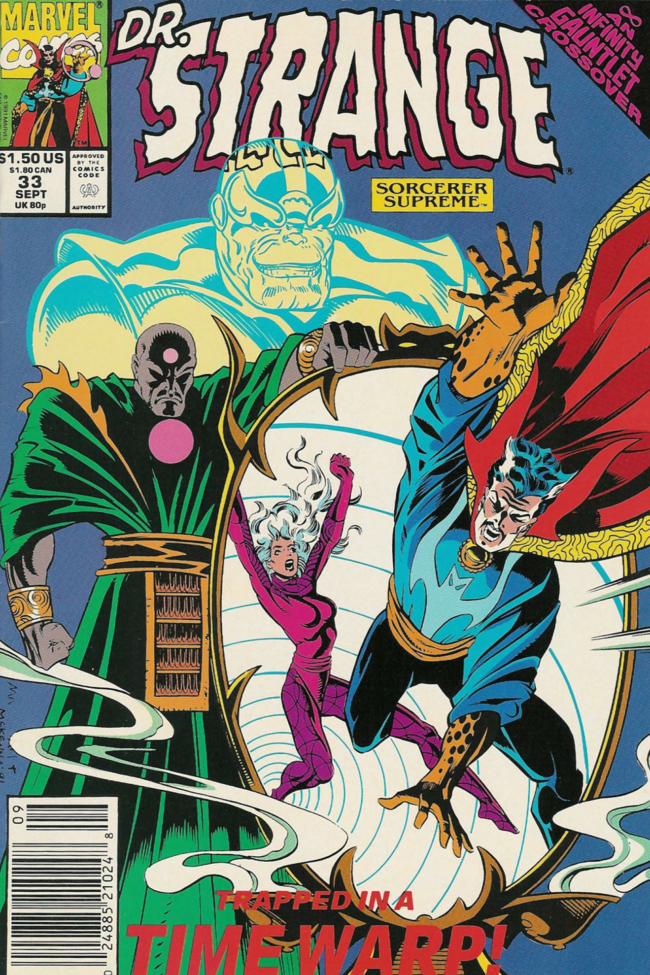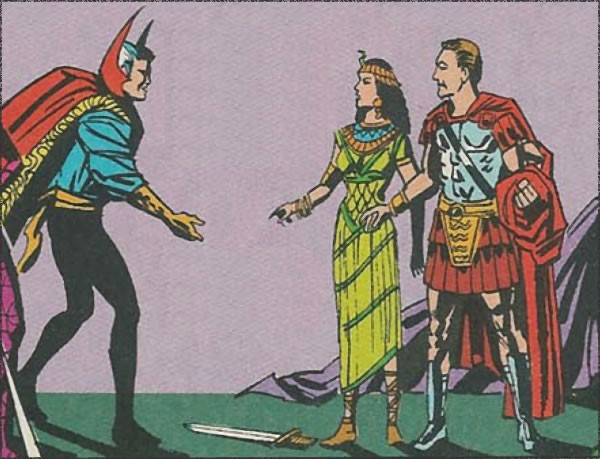In Dr. Strange, Sorcerer Supreme 33 (1991), the mystic tangles with Thanos who sends the sorcerer back in time via a time warp. As he floats back in history, Strange manages to latch onto a place (Alexandria, Egypt) and a year (48 BC) to stop the backward momentum (these sorts of things happen often with the sorcerer).
There, he meets some familiar characters—Caesar and Cleopatra.
As Dr. Strange spends the issue trying to figure out how to return to the present (back to the future?), the writers explore an age-old controversy in ancient history—the burning of the Library of Alexandria. Strange tells us “Hellenistic scholars amassed hundreds of thousands of scrolls–in an attempt to collect ‘the books of all the peoples of the world.’” The library was vast and one ancient historian put the count of scrolls at 700,000.
This excites our sorcerer, as that would include magic scrolls that might provide a fresh spell for getting back to the future. Strange is educated enough to know
Despite the popular legend of the library’s burning, there’s no historical evidence it ever happened—In fact, quite the contrary. A Roman named Lucan wrote about the defensive fire set by Caesar’s troops near the docks and how it burned some warehouses in which “grain and books” were stored for export!
That is a shortened version of the Roman poet’s dramatic account. In it, he tells us that once the dwellings near the sea caught fire,
the flame, struck
by a whirlwind, ran through the dwellings as swiftly
as a meteor often races with its trail in the ether,
though lacking fuel and burning thanks to air alone (10.500-503).
Keeping in mind that Lucan wrote that about 100 years after the events at Alexandria, Caesar provides a much more subdued version. In his Civil War, he tones down the drama, explaining that he
burned all of the enemy ships, plus the others in the boatyards, because he could not guard so much territory with his small corps (3.111).
There is no mention of burning buildings near the dock. Yet, while Lucan and Caesar failed to mention the Library of Alexander, there are other ancient historians who gave credence to the incident.
More than 100 years later, Plutarch would tell us that “in order to save his fleet from being cut off he had to repel the danger with fire, which then spread from the docks and destroyed the great library” (Caesar 49.8). This is the earliest surviving ancient history that explicitly mentions the library burning at the time.
From there, we can find more ancient historians calling out Caesar for destroying Alexandria including Cassius Dio, Aulus Gellius, Ammianus Marcellinus, and Orosius, although some claim it was not his intent.
If Caesar’s destruction of the library was merely a “popular legend,” as Dr. Strange put it, then it’s one that has survived numerous historians. Still, it is a hot topic among historians even today, as they theorize whether Caesar destroyed some, all, or none of the library. For example, Peter Green believes it was at least partially burned, ((Peter Green, Alexander to Actium: The Historical Evolution of the Hellenistic Age (Berkeley: University of California Press, 1990), 667, 906n151.)) Stanley M. Burstein believes “much of the area was destroyed by fire, including facilities connected to the famous Alexandrian library,” ((Stanley M. Burstein, The Reign of Cleopatra (Westport: Greenwood, 2004), 19).)) and Erich S. Gruen does not believe it was burned at all. ((Erich S. Green, “Cleopatra in Rome: Facts and Fantasies,” in Cleopatra: A Sphinx Revisited, ed. Margaret M. Miles (Berkley: University of California Press, 2011), 47, 52n53.))
As the library continued in some fashion after 48 BC (possibly rebuilt?), it would take the likes of Dr. Strange to prove definitively what happened that year.
This issue of Dr. Strange is available in a new Omnibus.


